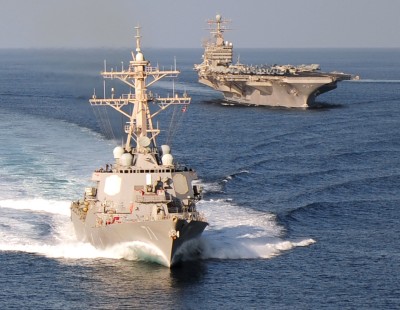
The guided-missile destroyer USS Ross (DDG 71) and the aircraft carrier USS Abraham Lincoln (CVN 72) cruise in a formation in the Gulf of Oman in 2010. When Naval Surface Warfare Center Dahlgren Division engineers installed the Joint Biological Point Detection System aboard USS Ross in September 2011, it became the 50th ship in the Fleet upgraded with near real time biological warfare agent detection, warning, identification and sample isolation capabilities. (U.S. Navy photo by Mass Communication Specialist 3rd Class Colby K. Neal/Released)
By John Joyce, NSWC Dahlgren Division Corporate Communications
NORFOLK, Va. (October 5, 2011)—The U.S. Navy's initiative to protect 128 warships with a new Chemical, Biological and Radiological (CBR) defense capability reached a significant milestone, a Navy CBR Defense official announced Oct. 5.
The installation of the Joint Biological Point Detection System (JBPDS) aboard USS Ross (DDG 71) in September makes it the 50th ship in the Fleet upgraded with near real time biological warfare agent detection, warning, identification and sample isolation capabilities.
"The JBPDS system is a terrific upgrade to my ship's combat capability," said USS Ross Commanding Officer Cmdr. David Wickersham. "I can detect biological agents earlier and react sooner to keep the crew safe. JBPDS enables Ross to operate with increased confidence in regions threatened by biological agents."
"This milestone is a highlight of my career and now I'm looking forward to the 100th shipboard installation of the JBPDS suite," said Mark Brown, Navy Program Manager for Biological Detection Systems. "The Joint Biological Point Detection System is a much needed biological warfare defense capability. The suite fully automates the biological detection, sample collection and identification functions, enabling Sailors to perform other critical duties."
Most importantly, the JBPDS capability - designed by Brown's team of Naval Surface Warfare Center Dahlgren Division (NSWCDD) civilian scientists and engineers - limits the effect of possible CBR exposures on U.S. forces, such as USS Ross warfighters, at the operational level.
"JBPDS provides commanders with the frontline knowledge necessary to effectively mitigate the after-effects of biological warfare agents," said Brown. "Prompt identification of biological agents and associated treatment will prevent the loss of personnel and help maintain mission readiness. JBPDS is the Navy's system of choice to combat the devastation that may be caused by a biological attack."
The fleet-wide installation of JBPDS - with hardware responsive to the maritime environment - that began on the Navy's guided missile destroyers and amphibious ship classes in 2005, will continue through fiscal year 2015.
"We are more capable to carry out our nation's calling," said USS Decatur (DDG-73) Commanding Officer Cmdr. Christopher Sweeney in November 2009 about the modular suite of equipment that supports his guided missile destroyer's mission with an ability to detect and identify biological warfare agents in near real-time.
The NSWC Dahlgren JBPDS team maintains continuous rapid detection and identification capability aboard ships - USS Ross and USS Decatur included - by providing complete system support anywhere in the world.
"This support includes new equipment training, pre-deployment training, reach-back troubleshooting, repairs, and logistics," said Brown. "After an installation, we provide ship personnel with the required training to operate and maintain the JBPDS. This training consists of 40 hours of classroom and hands-on training to include troubleshooting, operations and preventative maintenance services."
Refresher training is also available using course material located on Navy Knowledge On-line.
"The Navy's CBR Defense Division exists to provide our warfighter with the tools and capabilities necessary to detect, protect, and if necessary, decontaminate threats resulting from a CBR attack," said NSWC Dahlgren CBR Defense Division Head Mike Purello. "Our direct and active connection with the Fleet helps the warfighter and provides a wealth of valuable information for our scientists and engineers in the lab. This knowledge is immediately put to use as they work to create, develop, and provide updates and future solutions for our men and women in uniform."
A Navy leader in CBR Defense, NSWC Dahlgren's CBR Defense Division provides a full complement of capabilities that support the naval warfighter both on land and at sea as well as the joint and Homeland Defense communities.


